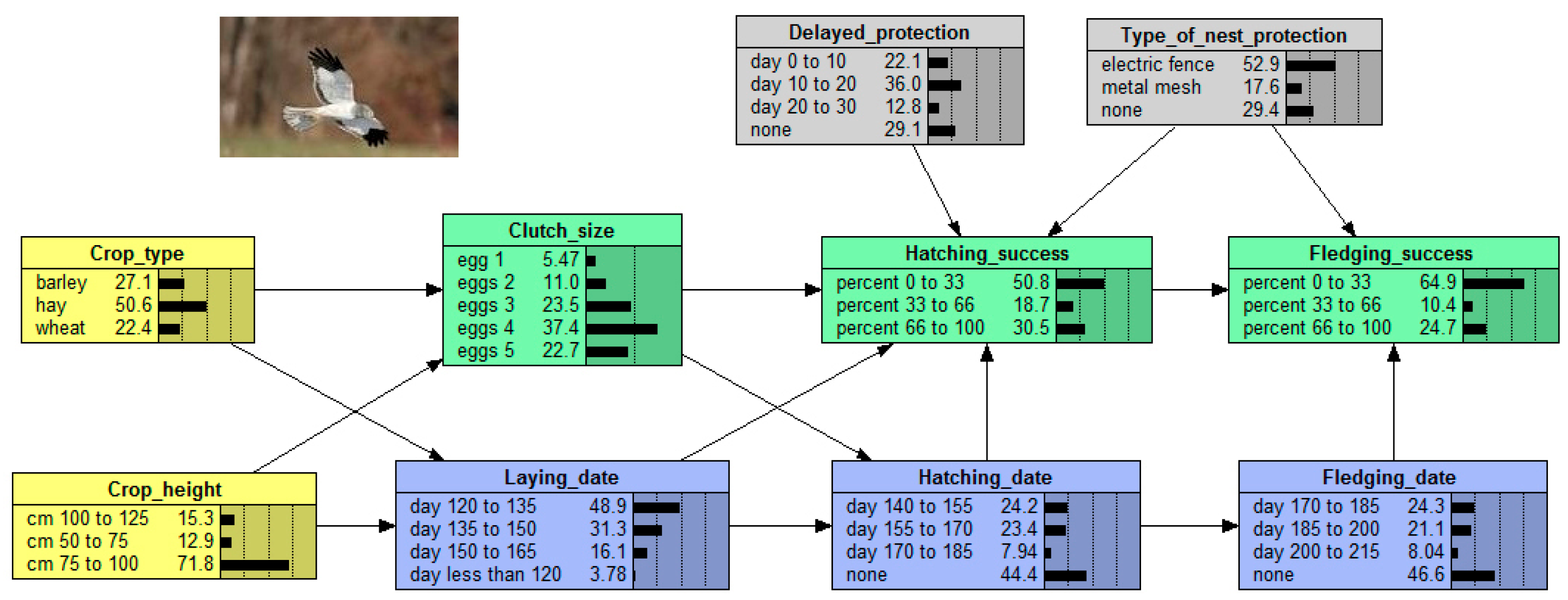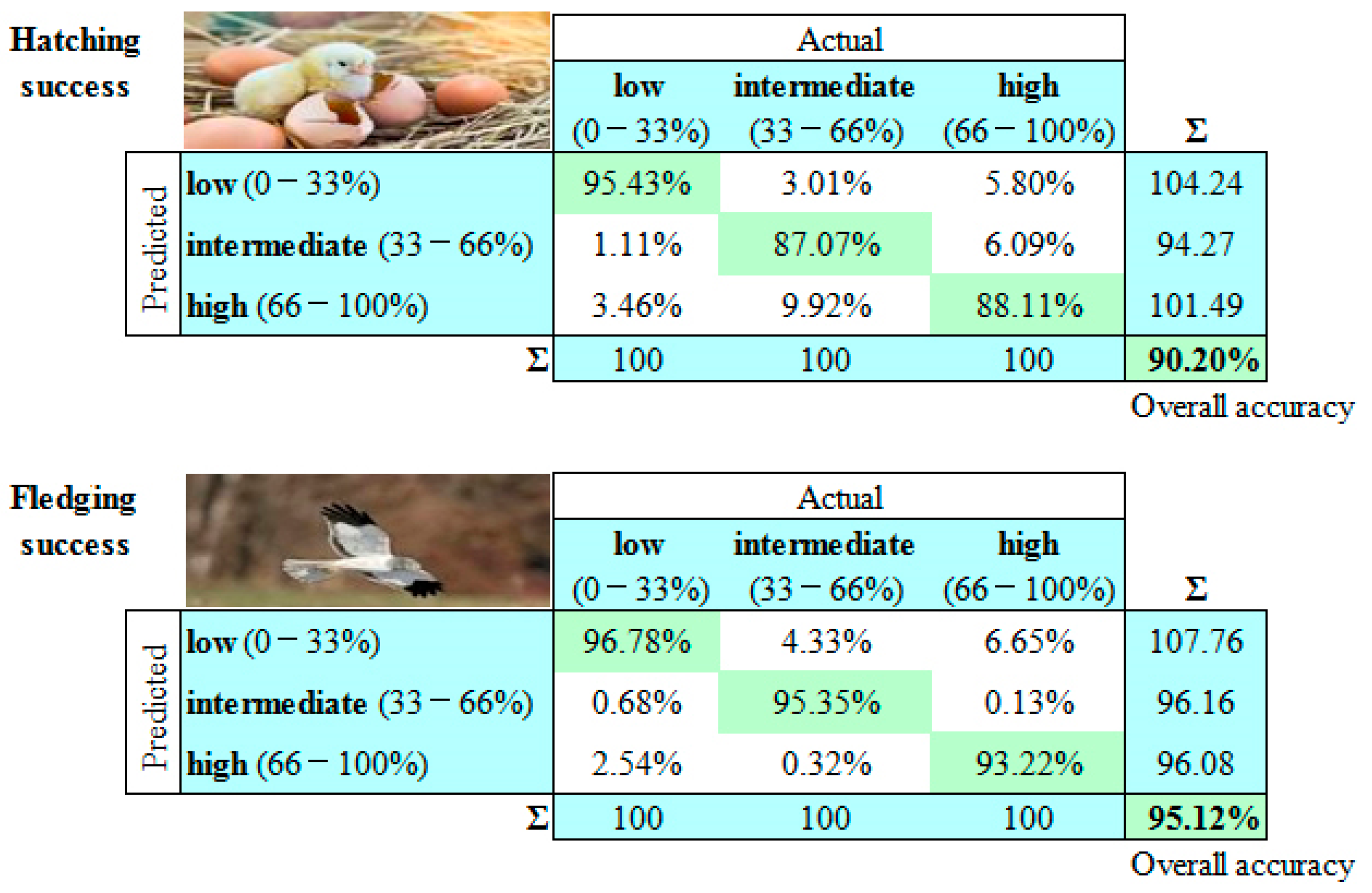Optimized Monitoring and Conservation of Farmland Bird Species through Bayesian Modelling: The Montagu’s Harrier Circus pygargus Population in Central Italy
Abstract
1. Introduction
2. Materials and Methods
2.1. Study Area and Study Population
2.2. Data Collection and Pre-Processing
2.3. Exploratory Analyses
2.4. Bayesian Network Modelling
2.4.1. Model Setup
2.4.2. Model Evaluation
2.4.3. Simulations
3. Results
3.1. Exploratory Data Analysis
3.1.1. Univariate Statistics
3.1.2. Bivariate Statistics
3.2. The Bayesian Network Model
3.3. What-If Simulations
3.3.1. Effects of Crop Type and Height on Egg Deposition
3.3.2. Effects of Egg Deposition and Nest Protection on Egg Hatching
3.3.3. Effects of Egg Hatching and Nest Protection on Fledglings
4. Discussion
Implications for the Monitoring and Conservation of the Montagu’s Harrier Population
5. Conclusions
Author Contributions
Funding
Institutional Review Board Statement
Informed Consent Statement
Data Availability Statement
Acknowledgments
Conflicts of Interest
References
- Donald, P.F.; Green, R.E.; Heath, M.F. Agricultural intensification and the collapse of Europe’s farmland bird populations. Proc. R. Soc. Lond. 2001, 268, 25–29. [Google Scholar] [CrossRef] [PubMed]
- O’Connor, R.J.; Shrubb, M. Farming and Birds; Cambridge University Press: Cambridge, UK, 1986. [Google Scholar]
- Guerrero, I.; Morales, M.B.; Oñate, J.J.; Geiger, F.; Berendse, F.; de Snoo, G.; Tscharntke, T. Response of ground-nesting farmland birds to agricultural intensification across Europe: Landscape and field level management factors. Biol. Conserv. 2012, 152, 74–80. [Google Scholar] [CrossRef]
- Chamberlain, D.E.; Fuller, R.J.; Bunce, R.G.H.; Duckworth, J.; Shrubb, M. Changes in the abundance of farmland birds in relation to the timing of agricultural intensification in England and Wales. J. Appl. Ecol. 2000, 37, 771–788. [Google Scholar] [CrossRef]
- Baker, D.J.; Freeman, S.N.; Grice, P.V.; Siriwardena, G.M. Landscape-scale responses of birds to agri-environment management: A test of the English Environmental Stewardship scheme. J. Appl. Ecol. 2012, 49, 871–882. [Google Scholar] [CrossRef]
- Böhning-Gaese, K.; Bauer, H.G. Changes in species abundance, distribution, and diversity in a central European bird community. Conserv. Biol. 1996, 10, 175–187. [Google Scholar] [CrossRef]
- Potts, G.R. The environmental and ecological importance of cereal fields. In The Ecology of Temperate Cereal Fields; Firbank, L.G., Carter, N., Darbyshire, J.F., Potts, G.R., Eds.; Blackwell: Oxford, UK, 1991. [Google Scholar]
- Tucker, G.M.; Heath, M.F. Birds in Europe: Their Conservation Status; Birdlife Conservation Series 3; Birdlife International: Cambridge, UK, 1994. [Google Scholar]
- Toivonen, M.; Herzon, I.; Kuussaari, M. Differing effects of fallow type and landscape structure on the occurrence of plants, pollinators and birds on environmental fallows in Finland. Biol. Conserv. 2015, 181, 36–43. [Google Scholar] [CrossRef]
- Benton, T.G.; Vickery, J.A.; Wilson, J.D. Farmland biodiversity: Is habitat heterogeneity the key? Trends Ecol. Evol. 2003, 18, 182–188. [Google Scholar] [CrossRef]
- Bowler, D.E.; Heldbjerg, H.; Fox, A.D.; De Jong, M.; Böhning-Gaese, K. Long-term declines of European insectivorous bird populations and potential causes. Conserv. Biol. 2019, 33, 1120–1130. [Google Scholar] [CrossRef]
- Inger, R.; Gregory, R.; Duffy, J.P.; Stott, I.; Voříšek, P.; Gaston, K.J. Common European birds are declining rapidly while less abundant species’ numbers are rising. Ecol. Lett. 2015, 18, 28–36. [Google Scholar] [CrossRef]
- Gilroy, J.J.; Anderson, G.Q.A.; Vickery, J.A.; Grice, P.V.; Sutherland, W.J. Identifying mismatches between habitat selection and habitat quality in a ground-nesting farmland bird. Anim. Conserv. 2011, 14, 620–629. [Google Scholar] [CrossRef]
- Donald, P.F.; Sanderson, F.J.; Burfield, I.J.; van Bommel, F.P.J. Further evidence of continent-wide impacts of agricultural intensification on European farmland birds, 1990–2000. Agric. Ecosyst. Environ. 2006, 116, 189–196. [Google Scholar] [CrossRef]
- European Environmental Agency. State of Nature in the EU. Results from Reporting under the Nature Directives 2007–2012; Technical Report N. 02/2015; EEA: Copenhagen, Denmark, 2015. [Google Scholar]
- Gustin, M.; Giglio, G.; Pellegrino, S.C.; Frassanito, A.; Ferrarini, A. New evidences confirm that during the breeding season Lesser Kestrel is not a strictly diurnal raptor. Ornis Fenn. 2017, 94, 194–199. [Google Scholar]
- Ferrarini, A.; Giglio, G.; Pellegrino, S.C.; Frassanito, A.; Gustin, M. First evidence of mutually exclusive home ranges in the two main colonies of Lesser Kestrels in Italy. Ardea 2018, 106, 85–89. [Google Scholar] [CrossRef]
- Ferrarini, A.; Giglio, G.; Pellegrino, S.C.; Gustin, M. A community-level approach to species conservation: A case study of Falco naumanni in Southern Italy. Diversity 2022, 14, 566. [Google Scholar] [CrossRef]
- Ferrarini, A.; Gustin, M. Spatio-temporal patterns of the Red-footed Falcon’s hunting behavior during the nestling period suggest ad hoc conservation policies. Avian Res. 2021, 12, 6. [Google Scholar]
- Ferrarini, A.; Gustin, M. First Record of the Red-Footed Falcon’s Nocturnal Flight Activity during the Nestling Period Using GPS Data. Ecologies 2022, 3, 58–65. [Google Scholar] [CrossRef]
- Ferrarini, A.; Gustin, M. Unsupervised Ethograms of a Vulnerable Bird Species: The Red-Footed Falcon in Northern Italy. Ecologies 2022, 3, 435–445. [Google Scholar] [CrossRef]
- BirdLife International. Circus Pygargus. The IUCN Red List of Threatened Species 2021: E.T22695405A201058261. 2021. Available online: https://www.iucnredlist.org/species/22695405/201058261 (accessed on 8 January 2023).
- Arroyo, B.E.; García, J.T.; Bretagnolle, V. Conservation of the Montagu’s harrier (Circus pygargus) in agricultural areas. Anim. Conserv. 2002, 5, 283–290. [Google Scholar] [CrossRef]
- Brichetti, P.; Fracasso, G. Ornitologia Italiana; Alberto Perdisa Editore: Bologna, Italy, 2003. [Google Scholar]
- Berger-Geiger, B.; Galizia, C.G.; Arroyo, B. Montagu’s Harrier breeding parameters in relation to weather, colony size and nest protection schemes: A long-term study in Extremadura, Spain. J. Ornithol. 2019, 160, 429–441. [Google Scholar] [CrossRef]
- Derlink, M.; Wernham, C.; Bertoncelj, I.; Kovács, A.; Saurola, P.; Duke, G.; Movalli, P.; Vrezec, A. A review of raptor and owl monitoring activity across Europe: Its implications for capacity building towards pan-European monitoring. Bird Study 2018, 65, S4–S20. [Google Scholar] [CrossRef]
- Brichetti, P.; Fracasso, G. The Birds of Italy, Volume 1: Anatidae-Alcidae; Edizioni Belvedere: Latina, Italy, 2018. [Google Scholar]
- Schaub, T.; Klaassen, R.H.G.; Bouten, W.; Schlaich, A.E.; Koks, B.J. Collision risk of Montagu’s Harriers Circus pygargus with wind turbines derived from high-resolution GPS tracking. Ibis 2020, 162, 520–534. [Google Scholar] [CrossRef]
- Muhlenbach, F.; Rakotomalala, R. Discretization of continuous attributes. In Encyclopedia of Data Warehousing and Mining; Wang, J., Ed.; IGI Global: Hershey, PA, USA, 2005; pp. 397–402. [Google Scholar]
- Pearl, J. Probabilistic Reasoning in Intelligent Systems: Networks of Plausible Reasoning; Morgan Kaufmann Publishers: Burlington, MA, USA, 1988. [Google Scholar]
- Spirtes, P.; Glymour, C.; Scheines, R. Causation, Prediction, and Search; MIT Press: Cambridge, USA, 2000. [Google Scholar]
- Jensen, F.V. An Introduction to Bayesian Networks; UCL Press: London, UK, 1996. [Google Scholar]
- Norsys. Netica Application User’s Guide; Norsys Software Corporation: Vancouver, BC, Canada, 1998. [Google Scholar]
- Norsys. Netica’s Help System; Norsys Software Corporation: Vancouver, Canada, 2011. [Google Scholar]
- Norsys. Netica Bayesian Belief Network Software; Norsys Software Corporation: Vancouver, Canada, 2013. [Google Scholar]
- Csikós, N.; Szilassi, P. Impact of Energy Landscapes on the Abundance of Eurasian Skylark (Alauda arvensis), an Example from North Germany. Sustainability 2020, 12, 664. [Google Scholar] [CrossRef]
- Traba, J.; Morales, M.B. The decline of farmland birds in Spain is strongly associated to the loss of fallow land. Sci. Rep. 2019, 9, 9473. [Google Scholar] [CrossRef] [PubMed]
- Newton, I. The recent declines of farmland bird populations in Britain: An appraisal of causal factors and conservation actions. Ibis 2004, 146, 579–600. [Google Scholar] [CrossRef]
- Newton, I. Farming and Birds; HarperCollins Publishers: New York, NY, USA, 2017. [Google Scholar]
- Arroyo, B.E.; Bretagnolle, V.; Garcia, J.T. Land use, agricultural practices and conservation of Montagu’s Harrier. In Raptors in a Changing Environment; Thompson, D.B.A., Redpath, S.M., Marquiss, M., Eds.; JNCC: Peterborough, UK, 2003; pp. 449–463. [Google Scholar]
- Arroyo, B.E.; García, J.T.; Bretagnolle, V. Montagu’s Harrier Circus pygargus. BWP Update 2004, 6, 41–55. [Google Scholar]
- Limiñana, R.; Surroca, M.; Miralles, S.; Urios, V.; Jiménez, J. Population trend and breeding biology of Montagu’s Harrier Circus pygargus in a natural vegetation site in Northeast Spain. Bird Study 2006, 53, 126–131. [Google Scholar] [CrossRef]
- Limiñana, R.; Soutullo, A.; Urios, V.; Surroca, M. Vegetation height selection in Montagu’s Harriers Circus pygargus breeding in a natural habitat. Ardea 2006, 94, 280–284. [Google Scholar]
- Koks, B.J.; Trierweiler, C.; Visser, E.G.; Dijkstra, C.; Komdeur, J. Do voles make agricultural habitat attractive to Montagu’s harrier Circus pygargus? Ibis 2007, 149, 575–586. [Google Scholar] [CrossRef]
- Millon, A.; Bourrioux, J.L.; Riols, C.; Bretagnolle, V. Comparative breeding biology of hen and Montagu’s harriers: An eight-year study in north-eastern France. Ibis 2002, 144, 94–105. [Google Scholar] [CrossRef]
- Corbacho, C.; Sánchez, J.M.; Sánchez, A. Breeding biology of Montagu’s harrier (Circus pygargus) L. in agricultural environments of southwest Spain; comparison with other populations in the western Paleartic. Bird Study 1997, 44, 166–175. [Google Scholar] [CrossRef]
- García, J.T.; Arroyo, B.E. Abiotic factors influencing reproduction in the centre and periphery of breeding ranges: A comparative analysis in sympatric harriers. Ecography 2001, 24, 393–402. [Google Scholar] [CrossRef]
- Korpimäki, E.; Wiehn, J. Clutch size of kestrels: Seasonal decline and experimental evidence for food limitation under fluctuation food conditions. Oikos 1998, 83, 259–272. [Google Scholar] [CrossRef]
- Arnold, J.M.; Hatch, J.J.; Nisbet, I.C.T. Seasonal declines in reproductive success of the common tern Sterna hirundo: Timing or parental quality? J. Avian Biol. 2004, 35, 33–45. [Google Scholar] [CrossRef]




| Variable | Data Type | Range | Discretization | Description |
|---|---|---|---|---|
| Clutch size | continuous | 1–5 eggs | 5 classes (1, 2, 3, 4, 5) | number of eggs laid |
| Crop height | continuous | 50–115 cm | 3 classes (50–75 cm, 75–100 cm, 100–125 cm) | mean crop height during April–July |
| Crop type | categorical | barley—hay—wheat | ||
| Delayed protection | continuous | 0–25 days | 4 classes (0–10, 10–20, 20–30, unprotected) | delay in nest protection in days from the laying date |
| Fledging date | continuous | 172–221 days | 4 classes (170–185, 185–200, 200–215, none) | fledging date in days from 1 January |
| Fledging success | continuous | 0–100% | 3 classes (low: 0–33%; intermediate: 33–66%; high: 66–100%) | % of chicks fledged with respect to the clutch size |
| Hatching date | continuous | 143–185 days | 4 classes (140–155, 155–170, 170–185, none) | hatching date in days from 1 January |
| Hatching success | continuous | 0–100% | 3 classes (low: 0–33%; intermediate: 33–66%; high: 66–100%) | % of eggs hatched with respect to the clutch size |
| Laying date | continuous | 114–164 days | 4 classes (< 120, 120–135, 135–150, 150–165) | laying date in days from 1 January |
| Type of nest protection | categorical | electric fence—metallic mesh—none |
Disclaimer/Publisher’s Note: The statements, opinions and data contained in all publications are solely those of the individual author(s) and contributor(s) and not of MDPI and/or the editor(s). MDPI and/or the editor(s) disclaim responsibility for any injury to people or property resulting from any ideas, methods, instructions or products referred to in the content. |
© 2023 by the authors. Licensee MDPI, Basel, Switzerland. This article is an open access article distributed under the terms and conditions of the Creative Commons Attribution (CC BY) license (https://creativecommons.org/licenses/by/4.0/).
Share and Cite
Ferrarini, A.; Calevi, E.; Brozzetti, D.; Colle, A.; De Santis, R.; Laurenti, S.; Savo, E.; Gustin, M. Optimized Monitoring and Conservation of Farmland Bird Species through Bayesian Modelling: The Montagu’s Harrier Circus pygargus Population in Central Italy. Sustainability 2023, 15, 4426. https://doi.org/10.3390/su15054426
Ferrarini A, Calevi E, Brozzetti D, Colle A, De Santis R, Laurenti S, Savo E, Gustin M. Optimized Monitoring and Conservation of Farmland Bird Species through Bayesian Modelling: The Montagu’s Harrier Circus pygargus Population in Central Italy. Sustainability. 2023; 15(5):4426. https://doi.org/10.3390/su15054426
Chicago/Turabian StyleFerrarini, Alessandro, Enzo Calevi, Dina Brozzetti, Alessia Colle, Riccardo De Santis, Stefano Laurenti, Enzo Savo, and Marco Gustin. 2023. "Optimized Monitoring and Conservation of Farmland Bird Species through Bayesian Modelling: The Montagu’s Harrier Circus pygargus Population in Central Italy" Sustainability 15, no. 5: 4426. https://doi.org/10.3390/su15054426
APA StyleFerrarini, A., Calevi, E., Brozzetti, D., Colle, A., De Santis, R., Laurenti, S., Savo, E., & Gustin, M. (2023). Optimized Monitoring and Conservation of Farmland Bird Species through Bayesian Modelling: The Montagu’s Harrier Circus pygargus Population in Central Italy. Sustainability, 15(5), 4426. https://doi.org/10.3390/su15054426






